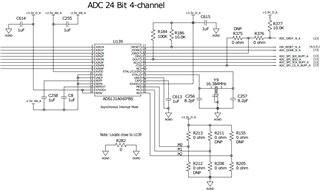Other Parts Discussed in Thread: AMC1350, THP210, LM7705
Tool/software:
For this circuit, we have a signal that is +/-7.5VDC input and want to read it on the ADC. We send the input signal through the AMC1350DWVR (U39) to isolate the signal from our digital ground. Then we send it through a low pass filter with a gain of 1.25 using the THP210DGK (U44). This then goes through the AAF circuit R263, C356, R338, C324, and C331 to go into the ADS131A04 ADC (U139).
For the ADC we have the Fmod = 2.048Mhz and the OSR to 2048 to sample at 1000Hz.
The issue we are having is when it reaches the AAF filter our circuit is no longer linear.
Below, is 4 points in the circuit I looked at for troubleshooting.
Input (Blue): Input of the analog chain that goes from -6.5VDC to 0VDC in -.5VDC increments.
AMC1350 OUT (Orange): Output of the AMC1350, U39
THP210 OUT (Light Blue): Output of the THP210 circuit, U44
ADC Input (Green): Input of the ADC
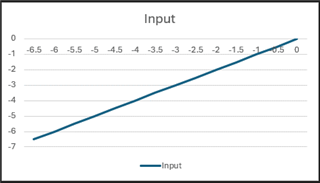
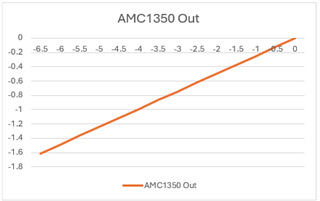
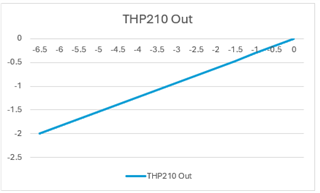
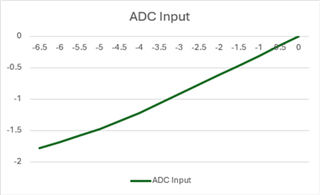
From these charts, I am noticing everything is linear up to the ADC input. I have tried adjusting my cutoff frequency of the RC circuit before the ADC but no luck.
Below is the data measurements used for the graphs above. It shows the gains are similar to what the design goal was besides the ADC input circuit.
|
Input |
AMC1350 Out |
THP210 Out |
ADC Input |
|
-6.497 |
-1.6116 |
-2.0016 |
-1.7798 |
|
-6.004 |
-1.4887 |
-1.8491 |
-1.6847 |
|
-5.508 |
-1.3656 |
-1.6963 |
-1.5849 |
|
-5.0095 |
-1.2424 |
-1.5431 |
-1.4765 |
|
-4.5112 |
-1.1186 |
-1.3894 |
-1.354 |
|
-4.0141 |
-0.9952 |
-1.236 |
-1.2176 |
|
-3.5026 |
-0.868 |
-1.0782 |
-1.0696 |
|
-3.0159 |
-0.7471 |
-0.928 |
-0.9247 |
|
-2.5174 |
-0.6232 |
-0.7742 |
-0.7732 |
|
-2.019 |
-0.4994 |
-0.6202 |
-0.6199 |
|
-1.519 |
-0.375 |
-0.4659 |
-0.4656 |
|
-1.0182 |
-0.2506 |
-0.3114 |
-0.3113 |
|
-0.5166 |
-0.126 |
-0.1566 |
-0.1566 |
|
-0.0153 |
-0.0015 |
-0.0019 |
-0.002 |



